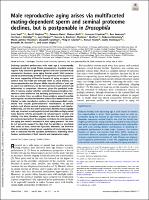Please use this identifier to cite or link to this item:
https://hdl.handle.net/20.500.12202/9934| Title: | Male reproductive aging arises via multifacetedmating-dependent sperm and seminal proteomedeclines, but is postponable inDrosophila |
| Authors: | Sepila, Irem Hopkins, Ben R. Dean, Rebecca Batha, Eleanor Friedman, Solomon Swanson, Ben Ostridge, Harrison J. Harper, Lucy Buehner, Norene A. Wolfner, Mariana F. Konietzny, Rebecca Thézénas, Marie-Laëtitia Sandham, Elizabeth Charles, Philip D. Sandham, Elizabeth Charles, Philip D. Fischer, Roman Steinhauer, Josefa Kessler, Benedikt M. Wigby, Stuart Stuart |
| Keywords: | seminal fluid sperm aging fertility fitness |
| Issue Date: | 2020 |
| Citation: | Sepil, I., Hopkins, B., Dean, R., Bath, E., Friedman, S., Swanson, B., Ostridge, H., Buehner, N., Wolfner, M., Konietzny, R., Thézénas, M.L., Sandham, E., Charles, P.D., Fischer, R., Steinhauer, J., Kessler, B.M., & Wigby, S. (2020). Male reproductive ageing arises via multifaceted mating-dependent sperm and seminal proteome declines, but is postponable in Drosophila. Proceedings of the National Academy of Sciences, 1-Jul, e202009053 |
| Series/Report no.: | Proceedings of the National Academy of Sciences;1-Jul, e202009053 |
| Abstract: | Declining ejaculate performance with male age is taxonomically widespread and has broad fitness consequences. Ejaculate success requires fully functional germline (sperm) and soma (seminal fluid)components. However, some aging theories predict that resources should be preferentially diverted to the germline at the expense of the soma, suggesting differential impacts of aging on sperm and seminal fluid and trade-offs between them or, more broadly, be-tween reproduction and lifespan. While harmful effects of male age on sperm are well known, we do not know how much seminal fluid deteriorates in comparison. Moreover, given the predicted trade-offs, it remains unclear whether systemic lifespan-extending interventions could ameliorate the declining performance of the ejaculate as a whole. Here, we address these problems using Drosophila melanogaster. We demonstrate that seminal fluid deterioration contributes to male reproductive decline via mating-dependent mechanisms that include posttranslational modifications to seminal proteins and altered seminal proteome composition and transfer. Additionally, we find that sperm production declines chronologically with age, invariant to mating activity such that older multiply mated males become infertile principally via reduced sperm transfer and viability. Our data, therefore, support the idea that both germline and soma components of the ejaculate contribute to male reproductive aging but reveal a mismatch in their aging patterns. Our data do not generally support the idea that the germline is prioritized over soma, at least, within the ejaculate. Moreover, we find that lifespan-extending systemic down-regulation of insulin signaling results in improved late-life ejaculate performance, indicating simultaneous amelioration of both somatic and reproductive aging. |
| Description: | Proceedings / National Academy of Sciences, 1 July 2020, e202009053 |
| URI: | https://www.pnas.org/doi/epdf/10.1073/pnas.2009053117 https://hdl.handle.net/20.500.12202/9934 |
| Appears in Collections: | Yeshiva College: Faculty Publications |
Files in This Item:
| File | Description | Size | Format | |
|---|---|---|---|---|
| Steinhauer 2020 OA-male-reproductive-aging-arises-.pdf | 8.73 MB | Adobe PDF |  View/Open |
This item is licensed under a Creative Commons License

